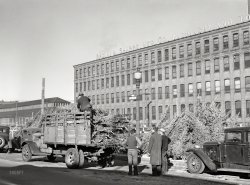
MAY CONTAIN NUTS

Search Shorpy
SHORPY ART

Framed or unframed, desk size to sofa size, printed by us in Arizona and Alabama since 2007. Explore now.
Join and Share
Ad-Free Shorpy
Shorpy is funded by you. Patreon contributors get an ad-free experience.
Learn more.

Recent comments
- Recent view
- Hudson’s Big Store
- Say what??
- Grapes?!
- A Beautiful Moment
- Such joy
- Bethune-Cookman University today...
- Yellow sky at morning
- Side Winder
- Air Quality?
- Sojourner Truth riot
- None were so blind(ed)
- The less famous sister
- Good ol' days?
- Rise and Fall
- Goo Goo Ga Joob
- Ticket Retention
- Not the only one
- Vagaries of War
- Killed by Amtrak
- Back to the Future
- Wanted --
- If you can't stand the light
- Centralized Traffic Control, I believe
- What's really happening
- Heckuva remote control!
- Sometimes — Things Go Bump!
- I SEE THE LIGHT
- Union Switch and Signal Company
- Get That Light Out Of My Eyes
Member Photos
The Shorpy
Print Emporium
Print Emporium
Search Shorpy
Search results -- 30 results per page
- Idyllic Avenue: 1905
- ... well-to-do have the means to move on.
(The Gallery, Bicycles, DPC, Streetcars) ... Posted by Dave - 05/27/2020 - 11:23am -
![Idyllic Avenue: 1905 Hartford, Connecticut, circa 1905. "Farmington Avenue." 8x10 inch dry plate glass negative, Detroit Photographic Company. View full size.
East of Prospect AvenueAlthough I can't pinpoint this location, the Sanborn fire insurance maps give some clues. The 1900 map shows Farmington developed out to about Prospect Avenue. It's residential much of the way back to the intersection with Asylum Avenue, although the lots get smaller as you head toward the river. The trees here are mature, maybe 30 or 40 years old, so unlikely to be a brand new, unmapped area, either. Somewhere between Prospect and Asylum, then.
If there were more details of the buildings, it might be possible to match the house shape and construction (plus the small cross street) with an existing building, but there's really not enough to go on here. If anyone wants to poke around, Yale University has made it easy. They have a tool that matches Sanborn maps to Google Earth. From Google Earth, you can click through to an image of each page of the corresponding Sanborn map. Here's the link for all of Yale's Connecticut maps. Scroll down for Hartford.
http://www.library.yale.edu/MapColl/print_sanborn.html
[Possible clues: Trolley pole No. 4074 at right, and the mailbox street sign. - Dave]
Give Them ClemencyMark Twain lived on this street. While it would be nice if this scene wasn't plowed-under today and replaced with CVS's and strip malls, you can't blame anybody for progress.
Too much changeFarmington Avenue has always been a major thoroughfare in Hartford. It is home to Mark Twain and Harriet Beecher Stowe's homes in the late nineteenth century- both modestly-sized but ornate residences in a neighborhood of literati. So much of the street was redeveloped, first in the 1920s, when many fine houses, mansions, and churches were torn down to make room for apartment buildings (still standing), and then again in the 1950s/60s to make way for a limited amount of strip development. I lived on Farmington Avenue for four years, and can't find a clue in this photo as to where it was taken along the street.
A few years ago the asphalt wore away in the road, revealing the buried trolley lines as well as original cobblestones. Very cool.
Cars Stop HereIn other words, that's where you catch the trolley, or get off of one.
It's true in almost every US cityToday, almost no one would want to build their impressive house on a street that becomes a main downtown thoroughfare. But 120+ years ago that is exactly where prosperous homeowners wanted to build. Fifth Avenue in New York and Euclid in Cleveland are two excellent examples. And today both of those streets also have almost no surviving private residences. Much beautiful residential architecture has been lost because commerce almost always triumphs and the well-to-do have the means to move on.
(The Gallery, Bicycles, DPC, Streetcars)](https://www.shorpy.com/files/images/SHORPY-4a12211a.thumbnail.jpg)
- Young Again: 1920
- ... Briggs and Stratton were sold seperately to be attached to bicycles. Most of the engines were sold for bicycles, and only a few for the Flyer.
(The Gallery, Cars, Trucks, Buses, ... Posted by Dave - 09/12/2011 - 12:06pm -
![Young Again: 1920 New York, 1920. Ms. Young returns, piloting a less imposing conveyance but still with a gleam in her eye. 5x7 glass negative, G.G. Bain Collection. View full size.
The Smith FlyerA company called A.O. Smith originally had the rights to these motors and along with Briggs manufactured the Smith Flyer. They were not very successful because of the lack of power. But B & S went on to become the small motor supplier for a multitude of uses.
Whatizit?It's a Smith Flyer.
[Close. Briggs & Stratton Motor Wheel. - Dave]
Fifth WheelMs. Young isn't exactly dressed for tinkering with a finicky one-lunger. Nonetheless she and her outfit are spotlessly clean. Her pit crew must be nearby. Wait'll her father finds out about the bad trade she made.
Nice go cartLooks like it might have blown some air somewhere unladylike, though....
You've just got to enjoy that fifth wheel for power.
Smith Motor WheelA.O. Smith purchased rights to manufacture the British-designed Wall Auto Wheel. They made a number of improvements to the original. Briggs & Stratton continued to improve it after their acquisition. A surprisingly large number have survived.
Red BugThis vehicle is known as the Briggs and Stratton Flyer. They were also called "Red Bugs" because they were painted red. I own an A.O. Smith Motor Wheel (just the engine). The engine, both the A.O. Smith and the Briggs and Stratton were sold seperately to be attached to bicycles. Most of the engines were sold for bicycles, and only a few for the Flyer.
(The Gallery, Cars, Trucks, Buses, G.G. Bain, NYC)](https://www.shorpy.com/files/images/30634u.thumbnail.jpg)
- College on Fire: 1963
- ... that day.
We could see the smoke. So we rode our bicycles over to see the fire from Wolfe Grade school. I was likely standing ... Posted by tterrace - 09/29/2011 - 8:25pm -
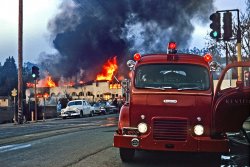
- Tall Beer: 1900
- ... In a number of Shorpy street scenes of this era, bicycles stand upright next to curbs (obviously, bike thieves were rare in ... ever seen as having fallen over. I am curious if vintage bicycles had some kind of special kick-stand to keep them tight against the ... Posted by Dave - 09/24/2015 - 12:52pm -
![Tall Beer: 1900 Milwaukee circa 1900. "Wisconsin Street and Pabst Building." The city's first sky­scraper, completed in 1891, demolished 1981. 8x10 glass negative. View full size.
Another point or two...Attached is a picture of the building that replaced the Pabst, taken from the south, pointing north. Some of the design themes of the original are evident in the new building. Also, I missed the Pabst sign in the lower left corner. It’s most likely at the entrance of a Pabst tavern, as all of the local breweries (5) had their own retail outlets. One other item of interest is the Milwaukee & St. Paul Ry. Ticket Office, across the street from the Pabst.
Silents, pleaseEdwin Thanhouser, manager of the Academy of Music, later went on to form one of the earliest motion picture studios, which produced over 1000 films from 1910 until it went kaput in 1918.
Foamy environmentThere's a lot going on in this picture! The crowd of people on the street, the streetcars, the really cool bridge, and all the aerial wires - the result of swift development of telegraph, telephone, and trolley and power wires - reveal a bustling excitement that was brewing in turn-of-the-century Milwaukee. I wonder if the brewery's founder's grand-daughter - who was vice-president of the company until 1894 - had anything to say about the building's design?
Short-SightednessWhy would they demolish such an iconic building?
[To make money from renting offices in a much larger modern building. - Dave]
Here there be dragons?Can we get a closeup of what appears to be a sculpture of a dragon at the top corner of the second floor of our skyscraper?
Tale of two townsA guy named Solomon Juneau is credited with founding Milwaukee. He developed the area between Lake Michigan (about a mile east of the Pabst Building) and the Milwaukee River, which is on the far side (west) of the building. A fellow by the name of Byron Kilbourn settled in and developed the area west of the river. If you can believe it, these two political powerhouses did not get along. So when Juneau built his streets to the river, Kilbourn, out of spite, offset his by about 100 feet or so from the center of Juneau’s. The net result was that when bridges were finally built they had to be angled (visible in image) to connect the streets. All of the river bridges in downtown Milwaukee have that feature.
Deja vu all over againAlthough I'm not from Milwaukee (I live on the opposite side of the country), I recognized this street scene immediately. When Wells Fargo Bank and Norwest Bank merged, I was sent to Milwaukee as a network engineer to site survey buildings in Wisconsin and Illinois. One of the buildings was 100 E. Wisconsin -- the location of this building. A few months later I returned to convert the building to the Wells Fargo network.
I checked on Google Earth just to make sure!
I live in Milwaukee and the view has changed...but the intersection of Wisconsin and Water is still the heart of downtown. Yes, we mourn the loss of the building in this photo, but, by 1981, it was a sad caricature of its former self - whitewashed, amputated and deformed beyond recognition.
Bicycle Built for One?Are my eyes deceiving me, or is the young man near the bottom of the photo riding a unicycle?
[No; the angle obscures the rear tire, besides, the handlebars are visible, -tterrace]
Also, thanks to kreriver for the interesting history lesson. I love stories like that, stories that most visitors or non-natives would never hear about a town.
Question for vintage bicycle expertsIn a number of Shorpy street scenes of this era, bicycles stand upright next to curbs (obviously, bike thieves were rare in those days). None are ever seen as having fallen over. I am curious if vintage bicycles had some kind of special kick-stand to keep them tight against the curb. Then again, they didn't have the suction caused by tractor semitrailers zooming along the streets.
[Here's a Shorpy example of how it was typically done using the pedals. In this Milwaukee photo, also note how high the curb is. -tterrace]
I was trying to understand....I was trying to understand why I did not know that building. It was because it was so stripped down when it was torn down. I've lived in Milwaukee all of my life.
There was a period in the 70's and 80's when any older building was just torn down because it was old. We lost a beautiful railroad train station that was at the lakefront and many other buildings.
(The Gallery, DPC, Milwaukee, Streetcars)](https://www.shorpy.com/files/images/SHORPY-4a08081a.thumbnail.jpg)
- City Hall: 1905
- ... out front seem to be precisely arranged. Not so the bicycles, but considering they had neither kickstands nor bike racks, but I can ... Posted by Dave - 08/05/2012 - 3:12pm -
![City Hall: 1905 Minneapolis, Minnesota, circa 1905. "Courthouse and City Hall." Look at the time! 8x10 inch dry plate glass negative, Detroit Publishing Company. View full size.
Looks the sameBut boy has the neighborhood changed!
The JailThat's Hennepin county jail, it might still be there. The proper entrance to the building has a quaint statue of a god, Poseidon perhaps, reclining on a cot.
TurnaboutThe view from the tallest tower on City Hall, in the direction of this camera location (on the top of the Metropolitan Building) is https://www.shorpy.com/node/6973. The state courts outgrew this Richardsonian building by the 1970s and moved a block south, and the jail moved a block east in 2001, but it remains the center of city governance.
A cathedral of governance!It embodies in stone the sacredness of democracy in the public mind at the time.
Love the beautiful frame houses in the neighborhood too - and it's charming to see the row houses.
Stone barrierIt's curious how there seems to be a barrier around 3 sides of the building. By the way it rises and hides 1st floor windows, it's on the higher-ground side. Perhaps a protection from water runoff? Yet there's a stairwell heading down halfway along it.
[The handy fence kept pedestrians from falling off the sidewalk into the light well as the street slopes up. - Dave]
His Left FootThe statue in the rotunda is "Father of Waters," sculpted by Larkin Goldsmith Mead. Legend says that rubbing his toe brings good luck. The left big toe is worn smooth.
Clean and symmetricalHave you ever seen such pristine sidewalks?? Or a better tribute to the stonemason?
Even the horses and carriages out front seem to be precisely arranged. Not so the bicycles, but considering they had neither kickstands nor bike racks, but I can bring myself to overlook this.
The rowhouses look like highly flammable Monopoly tokens.
I'm pretty sure this building was seen last year (pretty creepily in winter twilight) in "The First 48," a true-crime show on A&E.
TintinnabulationsWith such a beautiful tower as the crowning touch of this structure, I am curious if it included bells, if not for melodies, at least to mark the time. It appears there is some type of mechanism in the tower, but I can't make it out. Could any past or present residents of Minneapolis let us know if the tower chimed, and if so, does it still chime today? I am interested to know what was housed in the tower structure and if it is still in use. I certainly wouldn't pass up an opportunity to go exploring in this building from basement to pinnacle.
Peal outThe tower has a 15-bell carillon, and noontime concerts are still played. The bells also chime at the quarter hours. I don't know what the tower was used for, but a trip to the bell loft is unnerving. A tiny elevator and rickety stairs gets you to a beautiful view.
Look out! It's santa!That elegant tile roof was replaced not more than 5 decades later with some lame copper sheeting. When tiles cracked from the cold, they broke free and impaled pedstrians. Now you have to worry about giant icicles sliding off the copper all winter long.
And on another note, the "Father of the Waters" used to get all dragged out for Christmas. Frightfully so.
Beyond the BellsLongshanks is right - a wee slow elevator takes you up to the bells. Not recommended for the claustrophobic. You can walk if you wish; a tight, dusty, dim spiral staircase goes up to the chimes we well. But that's not as high as you can get: look at the full-size view, and find the tiny semi-circles at the peak of the tower. That's another floor, and they change the flag from those windows.
I've been up there. It was easier to get into East Germany in 1964 than to get into that space, but we did it - and to get down you have to walk backwards in the dark over a three-story void.
It's an amazing building. Just wish it wasn't puce.
(The Gallery, DPC, Minneapolis-St. Paul)](https://www.shorpy.com/files/images/4a12296a.thumbnail.jpg)
- Fasten Your Seatbelts: 1912
- ... Glenn Curtiss, the plane's designer, started out racing bicycles and motorcycles. It seemed perfectly natural for him that you'd make ... Posted by Dave - 07/22/2012 - 6:58pm -
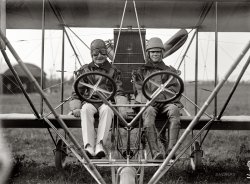
- Valley Green: 1909
- ... summer's hurricane, but they are rebuilding it. Horses, bicycles and dogs all patiently wait while their humans sip lemonade on the ... Posted by Dave - 07/19/2012 - 10:25pm -
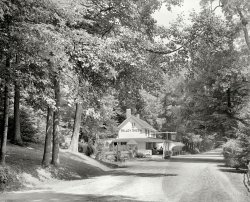
- Seventh Street: 1920
- ... Familiar Things Besides men in hats, ghostly images, bicycles, buggies and cars all at the curb, and trolley tracks, I seem to ... Posted by Dave - 09/13/2011 - 8:27pm -
![Seventh Street: 1920 Washington, D.C., circa 1920. "Goldenberg's, Seventh Street side." Another perspective on three places and one thing we've seen before on Shorpy. Who can link to them? National Photo Company glass negative. View full size.
Fourth familiar Shorpy thingMan in a hat - am I close?
Noon Time FriendThe "Noon Time Friend" Liberty Lunch wagon seems familiar, as does the bike with the jacked-up handlebars.
Canvas everywhereHad I been around during this time, I probably would have pursued opening a company that supplied awnings for buildings and roofs for cars. Walking inside the buildings, oilcloth coverings were on cabinets everywhere for protection. Oilcloth would have been my sideline.
On the other hand, the competition must have been tremendous.
FamiliarGoldenberg's, People's Drug and Hahn's ... ?
[Three out of four! - Dave]
Multiple Familiar ThingsBesides men in hats, ghostly images, bicycles, buggies and cars all at the curb, and trolley tracks, I seem to recall seeing the "Noon Time Friend" sandwich cart featured in a Shorpy posting before.
License PlatesWhy do you suppose that the two cars at the left each have two license plates? Is it one for Washington and another for the state of their residence at the time?
[You had to have plates for wherever your motor vehicle was operated. Many cars in Washington also had Maryland or Virginia tags. - Dave]
Peoples Store No. 1This would be The Link for the image of the Peoples Drug Store.
[Also here. And let's not forget Hahn's Reliable Shoe House.- Dave]
FamiliarThe lunch cart?
[Ding ding ding! You are correct. - Dave]
One more thing.Mold.
I would guessChestnuts roasting on the curb?
The Seven StoresWhen I was in high school in the 1940s, I worked at the Central Public Library at Seventh and K Streets, just off to the right of this scene. We always considered Goldenberg's to be a bargain department store. For example if something was cheap or looked cheap it "probably came from Goldenberg's basement." The other six department stores in D.C. were farther south on Seventh Street or farther west on F or G Streets.
Seventh Street: 1920 plus 90Here's the same view today.
The Hydrant Lives!I know I am a bit late in this (out of town). It appears to me that the fire hydrant on the corner may have outlived much of what has now been replaced.
(The Gallery, Cars, Trucks, Buses, D.C., Natl Photo, Stores & Markets)](https://www.shorpy.com/files/images/29484u.thumbnail.jpg)
- Bike Raffle: 1954
- ... The event began in the iconic city park, where the kids' bicycles were inspected and registered, and this raffle was held for a free ... barber.
Kids and Bikes Our small town required the bicycles to have small metal license plates on them. We kids would line up ... Posted by ZebraMan - 07/21/2013 - 8:08pm -
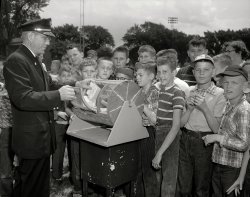
- The New Century: 1900
- ... pictures and this one has me convinced. The wicker pram, bicycles and now the "convertible" highchair were not average household items ... Father was a farmer, no photos exist of their early years. Bicycles would have been unthinkable.
(The Gallery, Found Photos, Kids) ... Posted by Dave - 11/23/2014 - 10:48pm -
![The New Century: 1900 "Lettis -- Ma and tot." From around 1900, it's Miss (or Mrs.) Handlebars again (and our third look at her house), along with another look at the baby. 4x5 glass negative, photographer and location unknown. View full size.
Family Treasure!I inherited a similar high chair from my grandmother, born in 1892. It folds down into a stroller and is still functional. Amazingly, so many things made in the past were built to last, as this chair has for several family generations.
Eye rollThe look on that baby's face slays me. "Take the dang picture already!"
Hybrid blouseIf you take the stripes of the highchair fabric and blend it with the dots of the baby's outfit, you get the striped/dotted pattern of the woman's blouse.
Chloe SevignyThe mother in this picture has a striking resemblance to Chloe Sevigny.
Toy phone?Is that a toy telephone on the high chair table in the style of the era?
[It's a cup on a leash, like the ball. -tterrace]
MoniedI got the impression these were well to do folks from some of the earlier pictures and this one has me convinced. The wicker pram, bicycles and now the "convertible" highchair were not average household items of the day. In the duo bike picture, one of the fellas is wearing a pretty nice watch chain too. For some reason I'm convinced her beautiful hair is red. Go figure.
[Their home, property, possessions and dress are not those of this period's wealthy. These folks are solidly middle-class. -tterrace]
I wasn't implying great wealth but for many "average" families of this time period a photograph was a big investment. Case in point my mother's family, 9 boys and her. Father was a farmer, no photos exist of their early years. Bicycles would have been unthinkable.
(The Gallery, Found Photos, Kids)](https://www.shorpy.com/files/images/SHORPY-139-02A.thumbnail.jpg)
- Seawater Baths: 1905
- ... someone enlighten me as to how they worked? Were they like bicycles or were they pushed? I've looked in Boardwalk Empire but he gives no ... Posted by Dave - 08/21/2012 - 6:58pm -
![Seawater Baths: 1905 Circa 1905. "Boardwalk, Atlantic City." Strollers on parade, at least one beach baby, and a number of ponies. Detroit Publishing glass negative. View full size.
Slowly --Careful with the baby!! My eye went straight to the ladies taking the stroller down to the beach. I just love how that moment was captured.
About those power linesHawk777-I'd slap a newborn for some of those beehive insulators off to the right.
Anyone expecting?
Baby Carriages and StairsI wonder about the baby in the pram. Was it a boy or a girl? How much of the 20th century was he/she around to see? My grandfather, born just three years later, said that he thought he'd been born at about the best time possible.
Better get a discount for thatIt's "Hot and Cold Seawater Baths"!. Charging for hot seawater baths I could see, but cold? Go swim with the fishies!
Rolling chairsI see several examples of rolling chairs in this photo. Can someone enlighten me as to how they worked? Were they like bicycles or were they pushed? I've looked in Boardwalk Empire but he gives no details about their mechanics.
[They're something of a Shorpy tradition: for example.]
Boardwalk eye candyBoth men and women are stealing glances of the slender young ladies in the center foreground. We'll never see what they saw.
The beach and people are nice butDave: best detail yet in all your pics of, er, powerlines.
What a waist. The lady in the foreground has quite the figure. Considering the glances within the photo in her general direction, I'm not the only one me thinks.
"But each day when she walks to the sea, She looks straight ahead not at me."
Rolling chairsThe rolling chairs are still part of Atlantic City. You pay someone with a chair and they push you on the boardwalk.
(The Gallery, Atlantic City, DPC)](https://www.shorpy.com/files/images/SHORPY_4a17294a.thumbnail.jpg)
- Old Money: 1914
- ... As a result, she bought the little house, bought her sons bicycles and later sent them to college. -- We always loved that story and ... Posted by Dave - 04/14/2012 - 5:05pm -
![Old Money: 1914 Washington, D.C., 1914. "Treasury Department -- Ofc. of U.S. Treasury -- second step in destruction of paper money. Machine cutting bills in halves." National Photo Company Collection glass negative. View full size.
Holy Crap!!!!Look at the bare terminals on the big electric motor under the table.
What is the first step?How can the second step be to cut a bill in half?
Watch out,the boss is taking a go on Old Nailcutter for the press.
The gentleman in the apron (presumably the regular operator of the machine) does look kind of wary. Like all practical people look when a suit from the head office takes over for a photo op.
Not on boardSays the guy in back: "This is bogus, man...I could by a house with just one of those wads."
High Tech SecurityShearing the bills lengthwise provides "extra" security before they are burned. That's one impressive paper cutter as evidenced by the size of the electric motor under the table. The exposed electric connections on the motor probably met the "OSHA" requirements of the day of "common sense" and a stern warning on your first day of work of "don't touch that".
A tale of old money for newAround 1924 a widow friend of my father's family moved into a tiny house in West Philadelphia. The house was a lowly place which suited her straitened means. She had four fatherless children and little hope, this being before the days of Social Security. One day in the attic above the stairs one of her sons found a box full of money! (The previous owner had died in the house, and must not have told anyone of his nest egg). It was about $1,000 of the old bills. -- She was thrilled, seeing at last some hope for her children and her future. But being old money, it seemed the banks would balk at exchanging it for new, and it would be considered worthless.
She approached my grandfather about what to do and he devised a plan where friends and family, just a few bills at a time, brought these old bills in to their local banks and had them changed for new, being just a few dollars at a time didn't cause consternation as a lump sum would have.
As a result, she bought the little house, bought her sons bicycles and later sent them to college. -- We always loved that story and especially its happy ending!
It’s all for the better.I didn’t care for the grouchy engraving of Salmon P. Chase either, so I got rid of my $10,000 bills the same way.
Handy and PracticalI need one of those machines--with the way money piles up, how else can you deal with it?
I bet Jack Benny hadI bet Jack Benny had nightmares of this room.
Granite tabletopsAlways good for rolling out dough.
[I think that's marble. - Dave]
(The Gallery, Natl Photo)](https://www.shorpy.com/files/images/SHORPY_31505u.thumbnail.jpg)
- Your Move: 1922
- ... motorists going any faster were trailed by policemen on bicycles. He had beats in the 1st, 5th, 6th and 9th precints.
During his ... Posted by Dave - 07/08/2014 - 1:20pm -
![Your Move: 1922 Washington, D.C., circa 1922. "Traffic court -- George H. Scriven, Otto G. Hauschild." Another moldy oldie from the National Photo vaults. View full size.
Weird white figureThere's a diffuse, irregular white circle that looks like damage to the image, but which is strictly contained by the boundary of the tabletop. How is that possible?
[It's mold on the emulsion. - Dave]
Boardwalk with a Motelis where you landed, and that'll be $10,000. Early Monopoly prototype?
Boys and their toysIf I had seen this photo when I was eight years old I'd have known what I wanted be when I grew up.
Subpoena the HorseHe saw everything!
Pre-ComputersInteresting to see how they handled such graphics problems before the computer. This does look like more fun. Movable pieces! Can anyone recognize the lapel pins these two gents are wearing?
DeskDon't look now but your drawers are open!
Drat!You sank my battleship!
Otto C. Hauschild
Washington Post, Mar 4, 1959
Otto Hauschild, Served as Policeman 44 Years
Otto C. Hauschild, whose 44 years on the Washington police force were a record in length and service when he retired in 1946, died of a stroke Monday at the Washington Hospital Center. He was 79.
When Mr. Hauschild joined the force in 1902, the speed limit was 4 miles an hour and motorists going any faster were trailed by policemen on bicycles. He had beats in the 1st, 5th, 6th and 9th precints.
During his longest assignment, from 1919 until retirement, he was an assistant in the Corporation Counsel's Office, preparing trial papers and conducting preliminary hearings in traffic cases.
Studying traffic problems, he hit on the idea of reconstructing traffic accidents with toy cars. His system became so successful that it was adopted across the country to clarify complicated collision cases in court.
Earning a law degree in 1928 from Georgetown University, he became the first policeman ever admitted to practice before the Supreme Court.
Your tax dollars at workThese guys cannot conceal their happiness in getting to play their favorite boyhood game of "cars and trucks" on company time and with those beautifully detailed and crafted vehicles. They may be in their forties but had to have had lots of fun creating the crash in the center of the model town and probably taking dibs on whose child is going to finally receive those marvelous toys.
FOB SOSI don't recognize the insignia on his watch fob. Is that a DC police fob?
(The Gallery, Cars, Trucks, Buses, D.C., Natl Photo)](https://www.shorpy.com/files/images/28675u.thumbnail.jpg)
- Rise & Fall: 1903
- ... But where are the automobiles? Plenty of carriages and bicycles seemed to be in full swing, though.
Street no longer so broad ... Posted by Dave - 05/18/2014 - 1:01am -
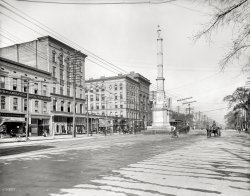
- Light Reading: 1941
- ... of this library, the more I think they should have rented bicycles so you could get from one section to the other.
I prefer my ... Posted by Dave - 09/05/2012 - 7:08pm -
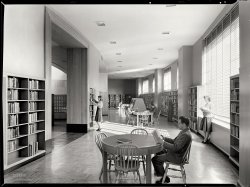
- Japanese Emporium: 1901
- ... decade of the twentieth century was the only time that bicycles were considered a legitimate mode of transportation. I read that the ... almost 120,000 miles on a bicycle, I can assure you that bicycles have always been legitimate transportation. The fact the the ... Posted by Dave - 08/28/2020 - 1:30pm -
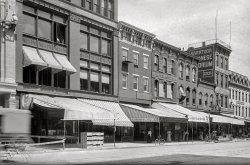
- Annisquam Light: 1910
- ... next to the rocks. As for the rest, little boats are like bicycles. They spend most of their time not being used. - Dave]
Sui ... Posted by Dave - 07/20/2012 - 1:34pm -
![Annisquam Light: 1910 Circa 1910. "Annisquam Light. Gloucester, Massachusetts." Detroit Publishing Company glass negative, Library of Congress. View full size.
Panchromatic filmThe dramatic skies are unusual for photos of this age. Most, if not all, of the emulsions used by photographers was orthochromatic (sensitive to blue and green light). It is true that panchromatic dyes were invented in 1904 (sensitive to all colors including red). And apparently this photographer had the red or orange filter necessary to make such dramatic skies. Alternatively, the picture has the wrong date. The other question is the relatively high ISO that allowed for a fast shutter speed and great depth of field. Aside from those puzzles it is a wonderful image.
[This photograph was made on glass, not film. - Dave]
Re: Panchromatic filmI've been following a the comments here for about a year now, and it always tickles me when the supposedly knowlegeable people expounding on this or that aspect of photography back in the Civil War era or early 1900s keep referring to "film."
Still looking good
It's still there.The lighthouse is still there (Wigwam Point, MA) but the photo is a reversed mirror image. The pier is gone and some other changes have been made through the years, but not much has changed at Wigwam Point.
[Your are correct. Maybe someone put the negative in the scanning frame backward when it was digitally imaged. In any case I've flopped it back again to conform with reality. - Dave]
Annisquam LightI drink it all day.
Film or plate?I probably didn't make the point carefully enough, but I don't think there were panchromatic "plates" - there was only panchromatic film to my knowledge. Maybe someone else knows more about that. I note in a later post that the "negative" was inadvertently reversed. I'm not sure of the process here where a "negative" is used for the scan or a plate.
[Like it says in the caption under the photo, this image was made from a glass-plate negative. - Dave]
Gone FishinI see lots of boats but no people in them. What's going on?
[There's a man rowing in the boat next to the rocks. As for the rest, little boats are like bicycles. They spend most of their time not being used. - Dave]
Sui generisThere is not another example on Shorpy of an image showing such detail in the skies in 1910.There has to be an explanation for this rather than just citing the LOC.
[There are more than a few, actually. The clouds that do show up tend to be low in the sky, as they are here. (Below, Nashville in 1864; click to enlarge.) Because the old emulsions were more sensitive to short (ultraviolet and blue) wavelengths than modern panchromatic b&w emulsions, high clouds tended to register only faintly, and 19th-century skies as depicted in photographs tend to be rather featureless and overexposed-looking. That's only a general rule, though. There are plenty of exceptions. - Dave]
A five minute exposureI appreciate the opportunity to understand these pictures. The image from Nashville is a long exposure, perhaps 5 minutes, perhaps more. What you have in the Annisquam Light is an almost instantaneous exposure that also has deep depth of field. And, in addition, there is the fleecy and round character of the clouds. There is no way to get there without a film emulsion that records all of the spectrum of light, which is what panchromatic emulsions did. I categorically state that you will not find another image that has all of these characteristics. And therefore, the description is wrong.
[Exposure times for outdoor glass plate photography in the 1860s were measured in seconds, not minutes. Below, an 1864 glass negative by Samuel Cooley, which, judged by the passage of the boat, couldn't have been exposed more than a few seconds. "Film emulsion" wouldn't enter into the discussion -- no film was used the the making of this picture; film didn't even exist during the Civil War. The lighthouse photo didn't use film, either. Taken by William Henry Jackson, it was the basis for this photochrom postcard dated 1904. - Dave]
(The Gallery, Boats & Bridges, DPC, W.H. Jackson)](https://www.shorpy.com/files/images/4a28702u_0.thumbnail.jpg)
- Mysterious Fire: 1912
- ... was to reverse the sizes of the wheels on pennyfarthing bicycles.
$75 today Adjusted for inflation, that's $1.6 MILLION dollars ... Posted by Dave - 08/07/2012 - 12:11pm -
![Mysterious Fire: 1912 May 24, 1912. "R.P. Andrews fire, 628 D Street N.W." Washington Post headline: "Mysterious Fire in R.P. Andrews Warehouse Does $75,000 Damage." The item goes on to say that the cause was thought to have been "wires connected with the electric elevator." National Photo Company glass negative. View full size.
Enough signsThank goodness there were enough signs so the firemen could find this obscure little business. I also think being next to the buffet helped.
Master detectives.Paper, paper, paper, stationery, stationery, paper, paper paper, and twine. Plus faulty wiring. And the place goes up in flames? A complete and utter mystery!
The "P" in "R.P. Andrews"......stand for Primatech, of course. This was a Company raid on an early group of Heroes led by Hosmer Higginbotham, whose superpower was to reverse the sizes of the wheels on pennyfarthing bicycles.
$75 todayAdjusted for inflation, that's $1.6 MILLION dollars today!
[Or would it be more like a billion? - Dave]
When the fire's out...Stop! Hammer time!
More fuel for the firePaint supplies and toilet paper. Those combustibles wouldn't have slowed things down. Both are advertised on the windows.
[The sign says "Printers' Supplies." - Dave]
Modesty PermitsNote the mention of TP in the window of R.P. Andrews' shop. I guess our Edwardian forefathers weren't as modest as I thought. I'm still kind of shy about carrying toilet paper home in my shopping bundle for all to see.
Hmm.Anyone know what the R.P. Andrews warehouse contained? I'm stumped...
(The Gallery, D.C., Fires, Floods etc., Natl Photo, Stores & Markets)](https://www.shorpy.com/files/images/31616u.thumbnail.jpg)
- Dirty Laundry: 1924
- ... wrist. - Dave]
Turning Those of us who ride our bicycles everywhere still use those hand signals.
Turn signal For a ... Posted by Dave - 08/09/2012 - 7:54am -
![Dirty Laundry: 1924 "Old Colony Laundry. Ford Motor Co." Washington, D.C., in 1924, when the streets were a honking sooty gridlock of trucks delivering diapers, blackberry pie and Whistle. Note the integrated, state-of-the-art turn signal attached to the cab. National Photo Company Collection glass negative. View full size.
Turn signalCheck out the state of the art turn signal (wooden hand just outside drivers door). Just pull the rope inside for a left turn. Umm, what do you do for a right? Maybe they only made lefts.
Blair Road"We Wash Everything but the Baby"
Located at Blair Road and Butternut Street NW in the Takoma Park section of Washington. The president and manager was Gordon W. Bonnette, perhaps that's him in the doorway.
FoMoCoFrom the Ford Motor Co. credit in the caption I guess this was taken for promotional purposes, showing the Model T hard at work. However, if that is the case, unlike most promotional material I've seen, this shows a very used and slightly battered example. I love the scrollwork brackets by the driver's head.
Hand SignalMaybe you just pull the rope part way for a left turn and pull a little more for a right. Looks like it could go higher than horizontal.
Left and RightI watched a video on the Jay Leno's Garage website the other night, about his Tatra T87 car, built before WW2.
It had the same sort of turn signal, only it was a little wand that flipped out. Jay said it was a handy thing for when you were out for a drive and stopped at an intersection. You could call a pedestrian over to visit and whap them in the head as they bent over to the window.
Regarding the turn signalIs it possible there's another wooden arm on the passenger side?
[It's a substitute for a regular hand signal. Which you'd give on the driver side using your arm to indicate either left or right turns, as well as stops. You wouldn't need one on the other side. - Dave]
Right TurnsIf I recall correctly, they used to bend their left arm at the elbow, with the forearm pointing to the sky to signal a right turn. Not sure how they'd do that with this inflexible wooden arm.
[It's hinged at the wrist. - Dave]
TurningThose of us who ride our bicycles everywhere still use those hand signals.
Turn signalFor a similar contraption in action, see Buster Keaton's 1922 film "Cops."
(The Gallery, Cars, Trucks, Buses, D.C., Natl Photo)](https://www.shorpy.com/files/images/31262u.thumbnail.jpg)
- One Star Hotel: 1906
- ... serifs, a surprising lowercase Gill Sans-ish precursor in "Bicycles and Sporting Goods."
Colourised for postcard! "A view of the ... Posted by Dave - 07/26/2012 - 11:16pm -
![One Star Hotel: 1906 Columbus, Ohio, circa 1906. "Hotel Star." Free telegraph in every room! 8x10 inch dry plate glass negative, Detroit Publishing Company. View full size.
Columbus, Arch Cityhttps://www.shorpy.com/node/8652
https://www.shorpy.com/node/8661
(fwiw, where I was born.)
Shock of the NewAmidst all the period capital serifs, a surprising lowercase Gill Sans-ish precursor in "Bicycles and Sporting Goods."
Colourised for postcard!"A view of the Star Hotel located at 227-229 North High Street, Columbus, Ohio. Also shows the metal arches over High Street."
From the Columbus Metropolitan Library.
At last, a dentist !For some time now, the Shorpy cityscape has not revealed the upstairs dental treatment that we were seeing much of a few months ago.
"May" the force be with youIn noticing the May & Co store on the right I remembered hearing the name over many years and decided to look them up. May & Company was founded 1877 by David May in Leadville, CO during the silver rush. Eventually becoming a nationwide chain, there is no connection to the NYC Mays Department Stores. In 2005 May & Company was merged into Federated Department Stores (Macy's Inc.) for $11 billion in stock.
[This May & Co. was a local Columbus furniture dealer and was not connected with the May Company department store chain. - tterrace]
North HighThe Puntenny & Eutsler music store was located at 231 North High street, so this whole block is gone. The Hotel Star address is 227 N. High.
The City of ArchesReplicas of the lighted arches still exist in Columbus Ohio on North High Street near The Ohio State University.
See "A Short Walking Tour" here.
Head to Toe ServiceBusiness must be good for the barber/shoeshine shop to have two fancy carved poles. While barber poles have been common and readily recognized for ages, this is my very first introduction to a shoeshine pole. I have to say it's attractive.
Come on down!
Woosh!I like the motion blur on the carriage moving out of frame. Zoom zoom!
(The Gallery, DPC)](https://www.shorpy.com/files/images/SHORPY_4a20851a.thumbnail.jpg)
- Walk Your Horse: 1910
- ... horses across bridges. Today, we only have to walk our bicycles across them!
Lower right corner Check out the 3-level diving ... Posted by Dave - 08/14/2012 - 7:13pm -
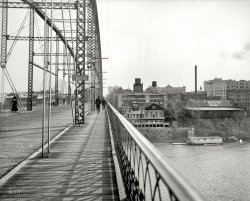
- Camping in Quebec: 1959
- ... a story about a couple guys like this who converted their bicycles to go on an abandoned railway. They headed west in search of ...
But yes, this picture is from the late 50s. These bicycles were relatively new CCM 3-speeds, with British Stermy-Archer rear ... Posted by Islander800 - 11/14/2014 - 7:38pm -
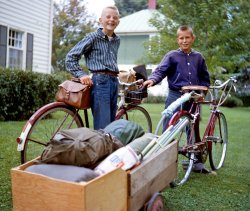
- Visitors Welcome: 1906
- ... racks in most of these photos, despite the abundance of bicycles.
Well, this place appears to have two!
Unfortunately, at ... Posted by Dave - 08/14/2012 - 10:47am -
![Visitors Welcome: 1906 Niagara Falls, New York, circa 1906. "Entrance, Natural Food Conservatory." Breakfast food pioneer Henry Perky's Shredded Wheat factory, a.k.a. "The Palace of Light," was a popular tourist attraction. Bring your appetite, and watch your step. 8x10 inch dry plate glass negative, Detroit Publishing Co. View full size.
They took paradise and put up a parking lot.The "Palace of Light" Shredded Wheat factory was apparently on the north side of the 400 block of Buffalo Avenue in Niagara Falls with a nice unobstructed view of the rapids near the falls.
The site is now a vacant lot with a nice view of the Ramada Inn between it and the rapids.
"The beautiful structure of The Natural Food Company is located on Buffalo Avenue (occupying ten acres), in the finest residence portion of the city, with a frontage of 900 feet on the Niagara Rapids."
Don't look up!I said DON'T look up, there's a guy in the window on the right watching us. Just act cool.
50,000 Vistors Annually!
"V"Why is "Natural" spelled with a "V"? Odd.
[Classicists will recognize that as a Latin (or Roman) U. - Dave]
Creepy, but at least there is a place for your bike...I've noticed people frequently commenting on the lack of bike racks in most of these photos, despite the abundance of bicycles.
Well, this place appears to have two!
Unfortunately, at least in this photo, it also looks like you might not need to secure your bike. After all, you won't be seeing it, or the light of day, again.
The uniforms look likeThey came from West Point, what the cadets wear.
Deveaux studentsMy wife grew up across the street from this building. Her brother attended Deveaux School and according to her the uniforms are identical to what the Deveaux students wore. The brother attend the prep school on a scholarship because their father was serving in WWII. The Deveaux school said the school was preparatory for entry into West Point, but few students actually became West Point Cadets.
(The Gallery, DPC, Factories)](https://www.shorpy.com/files/images/4a11844a.thumbnail.jpg)
- Geared to the Road: 1924
- ... light. I think it was just a reflector like they have on bicycles.
[It's a lamp with an electric bulb. - Dave]
Monochrome ... Posted by Dave - 05/23/2019 - 2:23pm -
![Geared to the Road: 1924 San Francisco circa 1924. "Hudson Super Six touring car at Spreckels Mansion." Plucked from the Shorpy Pantheon of Pharaonic Phaetons. Our title comes from the slogan on the car's gigantic Miller Cord tires. 5x7 glass negative by Christopher Helin. View full size.
I don't think ... ... the doors were poorly fitted. I think that's the way they were designed to look. Also I don't think that was a single brake light. I think it was just a reflector like they have on bicycles.
[It's a lamp with an electric bulb. - Dave]
MonochromeI'd love to see this colorized. In its present condition, it almost looks like Pershing's spare staff car.
No Okies HereAlthough it was a Hudson Super Six of this vintage that years later purportedly carried the semi-fictional Joads from Oklahoma to California in "The Grapes of Wrath," it is extremely unlikely that theirs featured double-sided whitewalls or full spare wheels (as opposed to merely the demountable rims). Nor was their Hudson likely to have bristled with padlocks like the photo car -- quite an oddity considering that anyone possessing a short length of wire could have made off in minutes with the entire vehicle.
Just for hooligansThe spare tire has a padlock. I didn't know that feature was required then.
We just love rooting through customers' cars looking for the key for the locking lug nuts. In a perfect world, the last people that touched it put it back where it belongs.
Once in a while we will get a car owned by a packrat. Stuff piled to the ceiling, with who knows what living under the pile of magazines and old food. The trunk is usually stuffed too, and the key is buried somewhere in there.
No one really steals alloy wheels anymore so we usually use our special tool to get the locking lug nut off, and install four new lug nuts to match the others.
Give me a brakeCheck out the puny single brake light, placed low where no one will see it.
Several degrees from ElvisThe Spreckels mansion was designed by George A. Applegarth for Adolph B. Spreckels, an heir to the Spreckels Sugar Co. fortune. At 2080 Washington Street, it is currently the home of romance novelist Danielle Steel. Judy Spreckels, the ex-wife of Adolph Jr., became a huge fan of Elvis Presley, traveling and hanging with him and his entourage in LA, Vegas and Memphis.
OdditiesI suppose the padlock on the sidemount spare might have been justified, but it is curious that the one on the external trunk is used not to protect the contents but rather to keep the entire trunk secured to the vehicle. I also had not noticed before the vertical bars between the trunk and the rear of the car body, presumably to prevent movement of the trunk from damaging the body panels.
The other thing that is revealed by the shadows is the shockingly poor fit of the doors, which seem to jut out at the bottom from the body structure itself. Odd on what is otherwise an impressive-looking vehicle.
Trunk or bootI see why we still call that space in the back of our cars a trunk. It was a trunk. So why do the British call it a “boot?” Perhaps someone can enlighten me.
[The boot locker was where your coachman or driver kept his boots. - Dave]
(The Gallery, Cars, Trucks, Buses, Chris Helin, San Francisco)](https://www.shorpy.com/files/images/SHORPY-1389.thumbnail.jpg)
- Thanks Sherman?
- ... between the States. If nothing else, the poster selling bicycles shows the picture is much later - probably 1880's or later.
It ... Posted by Loneliness - 09/09/2011 - 10:18pm -
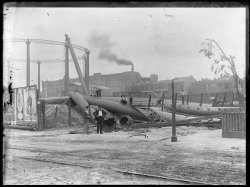
- Big City: 1941
- ... they all seem to be converging. Today he'd have to include bicycles and skateboards I suppose.
(The Gallery, Cars, Trucks, Buses, NYC, ... Posted by Dave - 08/24/2018 - 10:47am -
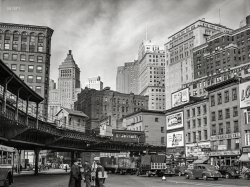
- Orders Neatly Boxed: 1940
- ... in them it seems from hardware to auto accessories to bicycles and tools. Another venerable institution that's bitten the dust.
... Posted by Dave - 12/26/2012 - 9:39pm -
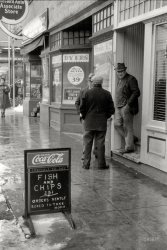
- Fayette Street: 1910
- ... then.
I take that back, there are two unattended bicycles confidently left by their owners. Try that nowadays!
(The Gallery, ... Posted by Dave - 08/20/2012 - 10:21am -
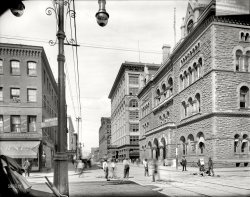
- Arnold Park: 1905
- ... on this street, only narrow curb cuts that must be for bicycles or wagons or pushcarts or something. My 21st Century mind kept telling ... Posted by Dave - 08/01/2012 - 1:42pm -
![Arnold Park: 1905 Circa 1905. "Arnold Park -- Rochester, New York." 8x10 inch dry plate glass negative, Detroit Publishing Company. View full size.
This looks like the spotFirst pass through from the end, and the stonework entrance is still there.
View Larger Map
DrivewaysIt took me a while to realize there are no driveways on this street, only narrow curb cuts that must be for bicycles or wagons or pushcarts or something. My 21st Century mind kept telling me those were driveways until I looked closer. No cars? No driveways yet.
[Actually the words "driveway" and "driving" are products of the carriage-and-buggy era. Some of these homes may have had carriage houses with driveways to the street. Also note the curbside mounting blocks and hitching posts. - Dave]
Rochester MemoriesI didn't live in Rochester very long but I do remember it having more trees and railroad tracks than any city of its size.
There's one in every neighborhoodThe neighbor who piles up trash in his front yard. In Arnold Park, he lives in the house on the far left.
Champagne Anyone
Beautiful American Elm trees. Not may left in our cities any more due to dutch elm disease. What a shame!
Trees are mapleThose aren't Elm. Look at the leaves....those are all Sugar Maple.
(The Gallery, Rochester)](https://www.shorpy.com/files/images/SHORPY_4a18731a.thumbnail.jpg)
- Seasonal Greens: 1940
- ... when the family income was $85 a week, and you still had bicycles and Roy Rogers gun belts to pay for. Oh, and Slinkys and Silly Putty ... Posted by Dave - 12/03/2018 - 11:20am -
